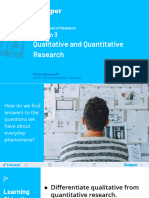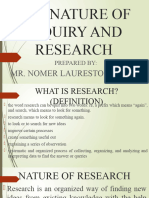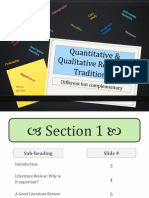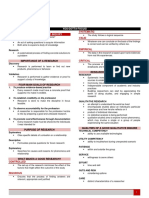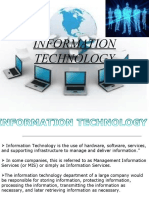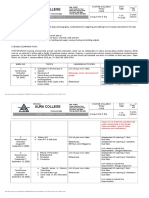0 ratings0% found this document useful (0 votes)
80 views65 pagesTools in Research
Uploaded by
beverly arevaloCopyright
© © All Rights Reserved
We take content rights seriously. If you suspect this is your content, claim it here.
Available Formats
Download as PDF or read online on Scribd
0 ratings0% found this document useful (0 votes)
80 views65 pagesTools in Research
Uploaded by
beverly arevaloCopyright
© © All Rights Reserved
We take content rights seriously. If you suspect this is your content, claim it here.
Available Formats
Download as PDF or read online on Scribd
You are on page 1/ 65
Importance of Research
Why
research
is
important?
ale Improves
é practice
Debates
The Scientific Method) and Its Applications in Research
Scientific
Method of
Linton
Educational
Research
Identifying a
research problem
Reviewing the
rature
- Collecting data
[Analyzing and
ee | interpreting data
* Analyze and nie
interpret the data
Identity a problem
that defines the
goal of research
Make a prediction
that, if confirmed,
resolves the
problem
Gather data
relevant to this
prediction
Reporting and |
evaluating research |
BY led mteSICe ein)
Basic and Applied Research
* Basic Research: Fundamental/ Pure research
— Concemed with the discovery of new knowledge and formulation of a
theory , invention of a new method or technique, or reflection; examination
of an existing knowledge in a different social or organizational context.
— Itis done for Expanding Knowledge, Curiosity or Interest,
— Eg. Researches related to Technology
* Applied Research
~ Its purpose is discovering, interpreting and developing methods and
systems for solving practical problems on a wide of real life
\dding additional know
E.g. Most medical researches
is secondary goal
Source: Fi
Desembo
€. (2014), Types of research Rotioved tom Retrieved on
Approaches to Inquiry
J —
+ Structured data + Unstructured data
+ Statistical analysis + Summary
* Objective conclusions + Subjective conclusions
+ Surveys, Experiments * Interviews, focus
Uy, groups, observations
"I drink c¢
Approaches to Inquiry
COMPARING QUALITATIVE & QUANTITATIVE RESEARCH |
CoE}
CEE Tc)
|Research Objects
Observe and Interpret
Unstructured. Free Form
Research is intimately
involved. Results are
subjective
Small samples —Often in
Natural setting
{Discover Ideas, with General
RESEARCH
ASPECT
Quantitative
CTT re)
Test Hypotheses or Specific |
Research Questions
COMMON PURPOSE
Measure and Test
TUT}
Structured Response
Categories Provided
Researcher uninvolved
Observer. Results are
Objective
J) Large samples to Produce
Generalizable Results
[Results that Apply to Other
Situations}
Characteristics of Quantitative Research
Leedy & Ormrod, 2001
1. Identifies a research problem.
Y Describing a trend means that the research problem
can be answered best by a study in which the
researcher seeks to establish the overall tendency of
responses from individuals and to note how this
tendency varies among people.
Example:
oe Population’s perception
ah Perception’s diversity
Characteristics of QUantitative Research
Leedy & Ormrod, 2001
1. Identifies a research problem
v¥ Some problems require to explain how one variable
affects another. By explaining their relationship, you
are interested in determining whether one or more
variables might influence another variable.
Example:
WHY? IS IT BECAUSE OF...
? > Gender?
% ne, Socioeconomic Status?
Attitude?
Characteristics of QU:
Leedy & Ormrod} 2001
2. Reviews literature
¥ Literature justifies the need for the research problem,
suggests potential purposes and researches
questions for the study.
| Example:
, The cause of problem?
DNS a2) Importance of peer groups
| teas oo Peek
q
aa Ramp). Styles of interacting
among student p.g.
racteristics of QUantitative Research
edy & Ormrod, 2001
3. Asks specific, narrow research questions to obtain
measurable and observable data on variables.
v The major statements and questions of direction in a
study—the purpose statement, the research
questions, and the hypotheses—are specific and
narrow because you identify only a few variables to
study. __. Role of the
School
Example: Counselor
Study of
Adolescent
Career
Choices
(OEVeleeilsiesy0))
faintitative Researc!
4. Collects numeric data from a population using
instruments with preset questions and responses
v You use an instrument to measure the variables in
the study. It contains specific questions and
response possibilities that you establish or develop
in advance of the study.
) Example:
Up
ere rr) rere
+Trre Tet tt
Pte r ert tt
rTrrrrere tt
te rerr re ret
+P Prere errs
rtrr rrr errs
Tht P eee eT
there tT ttt t
tte rer ret
Characteristics of QUanititative Research
Leedy & Ormrod, 2001
5. Analyzes data using mathematical procedures, ,
called Statistics.
v These analyses consist of breaking down the data
into parts to answer the research questions.
Statistical procedures such as comparing groups or
relating scores for individuals provide information to
address the research questions or hypotheses.
IES
Characteristics of Quantitative Research
Leedy & Ormrod, 2001
6. Writes the research report using standard, fixed
structures and evaluation criteria, and taking an
objective, unbiased approach
Vv \t follows an overall format for a study follows a
predictable pattern: introduction, review of literature,
methods, results, and discussion. This form creates
a standardized structure for quantitative studies.
‘Meirlteercsicstel
Leedy & Ormrod, 2001
_ 1. Explores a problem and develops a, detailed
understanding of a central phenomenon.
¥ Qualitative research is best suited to address a
research problem in which you do not know the
variable and need to explore.
v A central phenomenon is the key concept, idea, or
process studied in qualitative research.
Example:
In a research problem—difficulty in teaching deaf
children—you require to:
Explore & Understand
Characteristics of Qualitative Research
Leedy & Ormrod, 2001
2. Pays less focus on literature as plays less
substantial role at the beginning
¥ Although you may review the literature to justify the
need to study the research problem, the literature
does not provide major direction for the research
questions. It relies more on the views of the
, participants in the study and less on the direction
7 identified in the literature by the researcher.
y Example:
Characteristics of Qualitative Resea
Leedy & Ormrod, 2001
3. States the purpose and research questions in a
general. broad way so as to the participants’
experiences
v The purpose statement and research questions are
y stated so that you can best learn from participants.
Vy, You research a single snomenon of interest and
| state this phenomenoi purpose statement.
Example:
Ty BN study, that examines the “professionalism” of
teachers, asks high school teachers, “What does it
mean-to be a professional?”
4. Collects data based on words from a small number
of individuals so that the participants’ views are
obtained.
wy Y You collect data to learn from the participants in the
yy study and develop forms, called protocols, for
— recording data as the study proceeds. These forms
j pose general questions so that the participants can
provide answers to the questions.
Sample Specimen of Interview Protocol
Commented Example of an Interview protocol
(UI co be fled in after the Ingen HN)
ple Specimen of Observational Protocol
ser is annoyed by the slow login process
Jses the “Calculate” button
Says something positive about the calculator feature unprompted
Asks for help with finding the “Management” page
Expected the process of adding a new contact to be much quicker
Discovered the voice feature
Understands the meaning of submitting a lead tequest
y Surprised (in a bad way) by the results page of the lead search
y ‘The user experiences flow
Y, Double-clicks icons (rather than single-clicks)
77, Confused by the last paragraph in the Lead page
Says that the Reports page has a clean look
home page
ithout filing in 2 mane
NE
LOMA
S
9
Complains about font size
Santee: Sharon T (9012) A Callaharative | ean UX Rasaarch Taal Res
Characteristics of QUalitative Research,
Leedy & Ormrod, 2001
5. Analyzes the data for description and themes using
text analysis and interprets the larger meaning of the
4 findings
y
v Typically, you gather a text database, so the data
analysis of text consists of dividing it into groups of
sentences, called text segments, and determining
the meaning of each group of sentences. Instead of
statistics, you analyse words or pictures to describe
the central phenomenon under study.
6. Writes the report using flexible, emerging structures
and evaluative criteria, and including the researchers’
subjective reflexivity and bias
y You employ.a wide range of formats to report your
studies. Good reports, however, need to be realistic
and persuasive to convince the reader that the study
is an accurate and credible account. To be reflexive,
you reflect on your own biases, values, and
assumptions and actively write them into the
research.
Characteristics of litative Research,
Leedy & Ormrod} 2007
6. Writes the report using flexible, emerging structures
and evaluative criteria, and including the researchers’
2 subjective reflexivity and bias
v You employ. a wide range of formats to report your
studies. Good reports, however, need to be realistic
and persuasive to convince the reader that the study
is an accurate and credible account. To be reflexive,
you reflect on your own biases,. values, and
assumptions and actively write them into the
research.
Similarities and Differences between Qn and Ql,
Leedy & Ormrod, 20011
SUES
Past
‘| Both follows the six steps in the Win establishing the importance of the:
process of research. problem, Qn uses the problem ’
section to direct the types of
questions or hypotheses asked in the —
study; QI uses it for central idea.
ie
Y Both may employ similar Qn uses more closed-ended
% approaches, such as interviews or approaches to identify set response
y observations. categories (strongly agree, agree)
while QI uses more open-ended
questions by asking general ones.
In data gathering, Qn uses statistical
analysis while QI analyzes words
(transcription from interviews), or
images (photographs).
In reporting, Qn follows a
standardized format whereas QI
yo larities| and) Differences between Qn and QI,
rd
3 negrepnc x
n earch earch = Method Research Pe
he Research Process
Research
Cycle
Research is a cyclical
process—actually, a
helical process. It i aN
beans with G a)
problem, sees the goal (=))
clearly, divides the ‘2
problem, postulates andorganes cola
tentative
solutions, gathers and
organises data, and
interprets the data
Leedy's & Ormrod|s Skills Needed to Design and
efeyate [tle Mintesiceelnern)
Using Library
Sources
i Lengthening
Solving i
Puzzles t Attention Span
4 er
|
ue Writing, Editing,
and More Writing
Important Ethical’ Issues in Conducting Rese
TOOLS OF
RESEARCH
Library and its Resources
How to access knowledge quickly and efficiently? —
v Use the library catalogs.
v Search for the CD-ROMS (compact disk-read-only
memory). Typical of this item can hold 650
megabytes of information, or 300,000 pages of
written text. An example is the 28-volume Grolier’s
Encyclopedia which can be stored on one 4.5-in. CD-
ROM.
v Look for the reference librarian.
v Browse the library shelves. Books are coded and
arranged according to two principal systems: the
Dewey decimal classification system and the Library
of Congress (LC) classification system.
Library and its Resources
Understanding the Dewe)
Decimal System
Peet o lly
(Drawing/Decorative
Arts)
43
Library and its Resources
@.9. BV < Pradical Theology
Spreific Subject
8.9, BV4501 = Practical Retgion. Ine Cfvistian
Lite
This putriperis 1aad a8 3 wyele number 4504
precedes 4802. The number afer fe ¢eamal to
(eae a6 AROMA 18, 22% succeded by.3
| “puthorTitle tntormation
The tctfor & typcatly the trctletier of the autores
last name, or the tlie, inthe caze of etted works.
Publication Dale
The Computer and its Software
The Internet
The Computer andlits Software
Telnet
User Input User Input and Client User Input
InClient ‘Commands in NVT In Server
Representation Representation Representation
NaS
Terminal TL *| >| Host
: Telnet Teinet
Prerinal —] Test FC internet “See! [operating
system | <1 SEE aedionsert |__| system
Host Output Host Output and Host Output
In Client Server Commands in In Server
Representation NVT Representation Representation
User a Remote
Terminal @ ie Host
e Computer andiits Software
File Transfer Protocol
¢ FTP (File Transfer Protocol) is the simplest and
most secure way to exchange files over the
Internet.
* Transferring files from a client computer to a server
computer is called "uploading" and transferring from
a server to a client is "downloading". a
* To access an FTP server, users must be able to
connect to the Internet or an intranet (via a modem
or local area network) with an FTP client program.
The Computer and its Software
(Internal Netwo
ag
Ger FIP Server FIP Client
Business partner gets access to
the file by accessing the share
folder on the file server.
Employee uploads file to be File is hosted on the FIP server
shared with a business partner. within the corporate network,
The Computer andiits Software
Electronic Mail or E-MAIL
cciBee. From
“eel
The Computer andlits Software
News
Subscriber
The Computer and its Software
For more questions, visit
the link below:
http://www.learnthenet.com :
3
The Computer ahdits Software
Read. the following scenarios. In each case, think
about how the researcher might use the Internet
to solve his/her problem.
1. Arwin is a professor at a small college. Although
his research is prominent in his field, few people
on campus share his enthusiasm for his
specialty—forensic pathology. Although Arwin ¢
avidly read relevant academic journals, he looks
forward to the annual meetings of ‘his national
organization, where he can exchange ideas with
others who have similar interests. He wishes that
such exchanges could occur more frequently.
The Computer and its Software
SOLUTION!
Being on one or more list servers might enable
Arwin to keep up with the current developments in
his field and communicate regularly with others in
his field. c
The Computer and its Software
Read the following scenarios. In each case, think
about how the researcher might use the Internet
to solve his/her problem.
2. Deirdre has a once-in-a-lifetime opportunity to
spend 6 months in Australia collecting data about
the various marine plants of the Great Barrier
Reef. Although she is excited about it, she realizes ¢
that the work of her campus research group will
suffer. Because of the distance, it will be difficult to
provide feedback on the group’s ongoing papers
and projects. Although Deirdre and her colleagues
can use the postal service to transport the work
between them, this will definitely slow the
progress of their work.
SOLUTION!
Deirdre can still be connected with her colleagues
at home via e-mail, and she can easily send
papers back and forth through file transfer
protocol.
The Computer and its Software
Measurement as a Tool of Research
Measurement is limiting the data of any
‘phenomenon—substantial or
insubstantial—so that those data may be
interpreted and, ultimately compared to
an acceptable qualitative or quantitative
standard.
Measurement as a Too! of Research
Measurement is limiting the data of any
phenomenon—substantial or insubstantial—so
that those data may be interpreted and,
ultimately compared to an acceptable qualitative
or quantitative standard.
| When we measure
| something, we set a limit
that restrain the data. (12
inches restraint a foot) _|
IWisretsuicclanternerctsie Uo) ol ilmtkstor-1Ker0)
Measurement is limiting the data of any
phenomenon—substantial or insubstantial—so
that those data may be interpreted and,
Observable objects are
measured—this is substantial
measurement. (ex. an engineer
«| measuring the span of abridge)
Measurement as a Tool of Research
Measurement is limiting the data of any
phenomenon—substantial or insubstantial—so
that those data may be interpreted and,
ultimately compared to an acceptable qualitative
or quantitative standard.
These are things that exist only as
concepts, ideas, opinions,
feelings, or other intangible
entities. (ex. measuring the economic
“health” of a business)
i Measurement as a Toollof Research
Measurement is limiting the data of any
phenomenon—substantial or insubstantial—so
that those data may be interpreted and,
ultimately compared to an acceptable qualitative
or quantitative standard.
SQQQANAEnNs
Data have been transformed into
units of discovery, of revelation, of
enlightenment, of insight that
|hasn’t seen before.
Measurement as a Tool of Research
Measurement is limiting the data of any
phenomenon—substantial or insubstantial—so
that those data may be interpreted and,
ultimately compared to an acceptable qualitative
or quantitative standard.
Norms, averages,
|accuracy of description
WIGS
Measurement as a Tool/of Rese:
i Four Levels of Measurement
Nominal level - data that is Interval level - similar to the
|
7
1
classified into categories and ordinal level, with the
cannot be arranged in any additional property that
particular order. meaningful amounts of
5: eye color, gender,
religious affiliation.
1 involves data
arranged in some order, but
the differences between data
values cannot be determined
or are meaningless.
‘During a taste test
of 4 soft drinks, Mellow
Yellow was ranked number 1
differences between data
values can be determined.
There is no natural zero point.
= Temperature on the
Fahrenheit scale.
the interval level with
an inherent zero starting point.
Differences and ratios are
meaningful for this level of
measurement
Monthly income
» Sprite number 2, Seven-up. of surgeons, or distance
number 3, and Orange Crush traveled by manufacturer's
umber 4 representatives per month.
Measurement as 0! Of Researc'!
4 ® Selection tools must be reliable and valid.
Reliability: the degree to which the tool measures the
same thing each time it is used.
y @ Scores should be close for the same person taking the
/ same test over time.
7 « Validity: Does the test measure what it is supposed to
measure?
sw
= Example: does a physical ability test really predict the job
performance of a firefighter?
. ¢ Managers have an ethical and legal duty to develop
good selection tools.
IVE IccMane mets UN Umtet-feTeln)
|
y
Statistics as a Tool of Research
" e Statistics give information about the data and “help
the human mind comprehend disparate data as an
organized whole”
e This information can be used to help give meaning to
the data (interpretation) c
e Descriptive statistics - summarize the general nature
_ of the data
' @ Inferential statistics — help make decisions about the
data (i.e., are the results statistically significant)
i The Human Mind|as a Tool of Research
}
i
_ The Human Mind as a Tool of Research
SSS
* @ The mind of a researcher must use all of the
information available to them to interpret the data to
arrive at logical conclusions to their meaning
e Deductive Logic
e Inductive Reasoning
e Scientific Method (identifying a problem, positing a 7
hypothesis, gather data, analyze and interpret the
data)
© Critical:thinking — evaluation information or
arguments in terms of their accuracy or worth
Z
GY
|
7
y
The Human Mind! as a Tool of Researc'
Logic
Ms. Jackson’s reasoning:
“If learning information in an integrative fashion is more
‘effective than learning information piecemeal, (premise 1)
If the kinds of questions learners ask themselves during
a learning activity influence how they learn, (premise 2)
If training in self-questioning techniques influences the
7,kinds of questions that students ask themselves, (premise 3)<
ISS
“ And if learning is reflected in the kinds of notes that
y \earners take during class, (premise 4)
Then teaching students to ask themselves integrative
questions as they study class material should lead to
class notes that are more integrative in nature (conclusion)
The Human Mind) as a Tool of Research: Inductive
RCE SOM
It begins with an observation.
People use specific instances or
‘occurrences to draw conclusions about
the entire classes of objects or events.
7Researchers observe a sample then draw
7conclusions about the population from
which the sample comes.
¥, Example:
SHOWS
c
A sociologist may conduct two surveys, one in 1885 and a second in 1995,
asking 500 people to describe their beliefs about AIDS and then draw
conclusions about how society's attitudes toward AIDS have changed over
time.
The Human Mind) as a Tool of Research: Critical
Thinking
People use specific instances or
occurrences to draw conclusions about
the entire classes of objects or events.
It involves evaluating information or
| arguments in terms of their accuracy and
“| worth (Beyer, 1985)
\
Example:
In history, scrutinizing events that definitely happened or maybe happened in
7 thepast. |
In psychology, evaluating the way a characteristic (intelligence, personality)
is measured
In anthropology, observing people's behaviors over an extended time and
speculating what those behaviors indicate about the society being studied.
The Human Mind as a Tool of Research: Critical
Thinkin
_ Forms of Critical Thinking (Halpern,
- 1998):
"4. Verbal reasoning- understanding or
_ evaluating the persuasive techniques
7 found in oral and written language
\\\\S
- 2. Argument analysis- discriminating
,, between reasons that do and do not
“ support a particular conclusion
The Human Mind as a Tool of Research: Critical
Thinking
Forms of Critical Thinking (Halpern,
1998):
3. Decision making- identifying and
judging several alternatives and selecting
the best.
4. Critical analysis of prior research-
evaluating the value of data and research
results'in terms of the methods used to
obtain them and their potential relevance
to particular conclusions.
Facility with Language as a Tool of Research
Words—even those as simple as cow—and the
concepts that the words represent facilitate our thinking
in several ways (Omrod,1999):
1. They reduce the world’s complexity.
“l see a herd of cows.”
i, 2. They facilitate generalization and inference drawing
| in new situations.
“You are passing through either dairy or beef country.”
3. They allow abstraction of the environment.
_ “It connotes characteristics such as female, supplier of
_ milk, economic asset (to the farmer).”
4. They enhance the power of thought.
“You think about other ideas, and form connections
and interrelationships among them.”
Communicating Effectively Through W
Guidelines in effective writing (Omrod,1999):
1. Say what you mean to say.
2. Keep your primary objective in writing your
paper in mind at all times, and focus your
discussion.accordingly
3. Provide an overview of what you will be talking
about.
4. Organize your ideas into general and more
specific categories, and use headings and
subheadings to guide your readers through
your discussion of these categories.
5. Provide transitional phrases, sentences, or
paragraphs that help your readers follow your
train of thought.
Communicating Effectively Through Writing
Guidelines in effective writing (Omrod,1999):
6. Use concrete examples to make abstract
ideas more understandable.
7. Use appropriate punctuation.
8. Use figures and tables when such
mechanisms can more effectively present or
organize your ideas and findings.
9. At the conclusion of a chapter or major
section, summarize what you've said.
10. Anticipate that you will almost certainly
have to write multiple drafts.
SHAHN
“Ts it difficult to
comprehend?
Perhaps.
But I believe it is
stll
worth trying.”
~Stephen Hawking on the
German-style board game Agricola
Texts
Ariola, M. (2006). Principles and methods of
research. Manila: Rex Book Store, Inc.
Creswell, John W. (2012). Educational research:
Planning, Conducting, and Evaluating
Quantitative and Qualitative Research, Fourth
Edition, New Jersey: Pearson Education, Inc.
Leedy, P & Omrod. (2013). Practical Research:
Planning and Design, 10" ed. New Jersey:
Prentice-Hall, Inc.
BNE IRINNCL=S
Electronic Sites
Firdawek, E. (2014). Types of Research, Retrieved from htipiwww-slideshare.neVaddisuaall3-tyoes-of-
tesearch. Retrieved on December 7, 2015.
Harris, B. (2006). Wellness Research Design Session 2. Retrieved from
e 4568571, Retrieved on December 7, 2015.
Othman, S. (2011), Qualitative vs Quantitative Research. Retrieved from
: bicusbalge ‘0d/qualitalive-\s-qual e Retrieved
on December 7, 2016.
Phelan, C. & Wren, J. (2006). Exploring Reliability in Academic Assessment. Retieved from
tips. uni.edu/chfasoalreliailtyandvalicy.him. Retrieved on December 14, 2015,
Pikuoee. (2009). Statistics. Retrieved from
Retrieved on December 7, 2015.
Sharon, T. (2013). A Collaborative Lean UX Research Tool, Retrieved trom:
‘nipiwwa_amashingmagazine.com/20 1310\rainbow-spreadsheetcolaboraive ux research 100!
Retrieved on December 7, 2018.
Smith, K. (2013). Introduction to Research. Retrieved Irom
Retrieved on December 7,
20"5,
Statistics Solutions ( ). Data Levels of Measurement. Retneved from
can saiatcssclutons convdaa-lvels ot measuremnt, Retreved on December 7. 2015.
You might also like
- Quantitative Qualitative: No Statistical AnalysisNo ratings yetQuantitative Qualitative: No Statistical Analysis7 pages
- Qualitative Research Difference Characteristicsstrenghts Weaknesses and TypesNo ratings yetQualitative Research Difference Characteristicsstrenghts Weaknesses and Types68 pages
- Comparison Qualitative Quantitative - KeyNo ratings yetComparison Qualitative Quantitative - Key14 pages
- Unit 1 Lesson 3 Qualitative and Quantitative Research LearnersNo ratings yetUnit 1 Lesson 3 Qualitative and Quantitative Research Learners29 pages
- 02 Qualitative Versus Quantitative Research100% (1)02 Qualitative Versus Quantitative Research30 pages
- LESSON FOUR - Designing Qualitative ResearchNo ratings yetLESSON FOUR - Designing Qualitative Research36 pages
- Session 1 - Introducing Qualitative ResearchNo ratings yetSession 1 - Introducing Qualitative Research26 pages
- Nature of Inquiry and Research: Some Research Ethics PrinciplesNo ratings yetNature of Inquiry and Research: Some Research Ethics Principles11 pages
- Qualitative Versus Quantitative ResearchNo ratings yetQualitative Versus Quantitative Research17 pages
- Week 1 Introduction of Qualitative ResearchNo ratings yetWeek 1 Introduction of Qualitative Research16 pages
- Quantitative & Qualitative Research: Adesas, Kristel Mae M. & Arce, Jeoffrey J100% (1)Quantitative & Qualitative Research: Adesas, Kristel Mae M. & Arce, Jeoffrey J30 pages
- WEEK 3 RESEARCH 1 UNIT 2 Qualitative Reasearch and Its Importance On Daily LifeNo ratings yetWEEK 3 RESEARCH 1 UNIT 2 Qualitative Reasearch and Its Importance On Daily Life39 pages
- Lesson 3 Diffentiating Qualitative From Quantitative Research AutosavedNo ratings yetLesson 3 Diffentiating Qualitative From Quantitative Research Autosaved39 pages
- An Introduction To Qualitative Research: For Teaching in Senior High SchoolNo ratings yetAn Introduction To Qualitative Research: For Teaching in Senior High School36 pages
- SUMMATIVE TEST IN PRACTICAL RESEARCH 1 Competency 4 5 6 and 7 STUDENT FACENo ratings yetSUMMATIVE TEST IN PRACTICAL RESEARCH 1 Competency 4 5 6 and 7 STUDENT FACE5 pages
- St. Jude Veterinary Management Information SystemNo ratings yetSt. Jude Veterinary Management Information System32 pages
- Introduction To Computing Syllabus 2022 2023No ratings yetIntroduction To Computing Syllabus 2022 20239 pages













